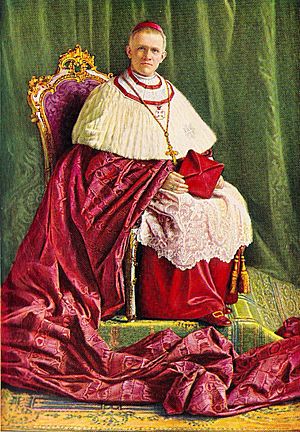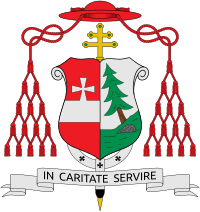Theodor Innitzer facts for kids
Quick facts for kids His Eminence Theodor Innitzer |
|
|---|---|
| Cardinal, Archbishop of Vienna | |
 |
|
| Archdiocese | Vienna |
| See | Vienna |
| Appointed | 19 September 1932 |
| Enthroned | 16 October 1932 |
| Reign ended | 9 October 1955 |
| Predecessor | Friedrich Gustav Piffl |
| Successor | Franz König |
| Other posts | Cardinal-Priest of San Crisogono |
| Orders | |
| Ordination | 25 July 1902 |
| Consecration | 16 October 1932 by Enrico Sibilia |
| Created Cardinal | 13 March 1933 |
| Rank | Cardinal-Priest |
| Personal details | |
| Born | 25 December 1875 Neugeschrei-Weipert, Kingdom of Bohemia, Austria-Hungary |
| Died | 9 December 1955 (aged 79) |
| Denomination | Roman Catholic |
| Coat of arms |  |
Theodor Innitzer (born December 25, 1875 – died October 9, 1955) was an important leader in the Catholic Church. He served as the Archbishop of Vienna and was also a Cardinal.
Contents
Early Life and Education
Theodor Innitzer was born in a town called Neugeschrei (now Nové Zvolání) in Bohemia. At that time, this area was part of Austria-Hungary. Today, it is in the Czech Republic. His father, Wilhelm Innitzer, worked in a textile factory.
Young Theodor started as an apprentice in a textile factory. However, the local church leader, called a dean, saw his potential. The dean helped Theodor go to a special high school called a gymnasium. He studied there from 1890 to 1898.
Becoming a Church Leader
After finishing school, Theodor Innitzer decided to join the church.
| Styles of Theodor Innitzer |
|
|---|---|
 |
|
| Reference style | His Eminence |
| Spoken style | Your Eminence |
| Informal style | Cardinal |
| See | Vienna |
- In 1898, he entered a seminary in Vienna. A seminary is a school where people train to become priests.
- He became a priest in 1902.
- In 1906, he earned a special degree called a Doctor of Theology (Dr. theol.). This means he studied religion at a very high level.
- From 1908 to 1932, he taught at the University of Vienna. He became a professor in 1911.
- He was even the head of the University of Vienna (called Rector) from 1928 to 1929.
- In 1929, he worked in the government for a short time. He was the Minister of Social Affairs.
- In 1932, he became the Archbishop of Vienna. This is a very important position in the Catholic Church.
- In 1933, he was made a Cardinal by Pope Pius XI. This is one of the highest ranks in the Catholic Church. He also helped start the Cathedral and Diocesan Museum in Vienna.
Challenges During World War II
Theodor Innitzer lived during a very difficult time in Austria, especially when the Nazis came to power. His actions during this period are still discussed today.
The Anschluss and Initial Support
In 1938, Nazi Germany took over Austria. This event was called the Anschluss. At first, Cardinal Innitzer and other Austrian Catholic bishops signed a statement that seemed to support this takeover. Cardinal Innitzer even signed it with "Heil Hitler!".
The Nazi government then spread this statement everywhere, even without the bishops' full permission. When Pope Pius XI heard about this, he was very upset. He ordered Cardinal Innitzer to go to the Vatican (the Pope's home).
Retraction and Nazi Anger
At the Vatican, Cardinal Innitzer met with Cardinal Pacelli (who later became Pope Pius XII). Cardinal Pacelli was very angry about Innitzer's statement. He made it clear that Innitzer had to take back his words.
So, Innitzer signed a new statement for all the Austrian bishops. It said that their first statement was "clearly not intended to be an approval of something that was not and is not compatible with God's law." This meant they did not support everything the Nazis did.
Standing Up to the Nazis
Even though he had initially signed the statement, Cardinal Innitzer later became a strong critic of the Nazis. In April 1938, he had ordered churches to fly the swastika flag for Hitler's 50th birthday. But his views changed.
On October 7, 1938, Innitzer held a special prayer day at the Cathedral of St. Stephen in Vienna. About 9,000 people, many of them young, came to listen. In his sermon, Innitzer bravely said that "we must confess our faith in our Führer, for there is just one Führer: Jesus Christ." This statement made the Nazi leaders furious.
The very next day, about 100 Nazis, including members of the Hitler Youth, attacked the archbishop's home. They broke furniture and threw documents out the windows, setting them on fire. People shouted angry words like "down with the clergy" and "send the Cardinal into a concentration camp." This event showed that Cardinal Innitzer was now openly against the Nazis' anti-Catholic actions.
During World War II
Cardinal Innitzer also spoke out against the Nazis' cruel treatment of Austrian Jews and Romani people (sometimes called gypsies). He was against their racist policies.
He also spoke about the war itself. He saw the war as a punishment from God for people's wrongdoings. He was sad that fewer people were going to church and that religious teaching was being stopped in schools. These comments were a way of criticizing the Nazi government, which was trying to reduce the church's influence.
Death
Cardinal Theodor Innitzer passed away in Vienna on October 9, 1955.
Kardinal Innitzer Prize
To honor Cardinal Innitzer, the Archdiocese of Vienna gives out the Kardinal-Innitzer-Preis every year. This award recognizes important work by scientists and scholars.
See also
 In Spanish: Theodor Innitzer para niños
In Spanish: Theodor Innitzer para niños
- List of Austrians
- List of Austrian Politicians

